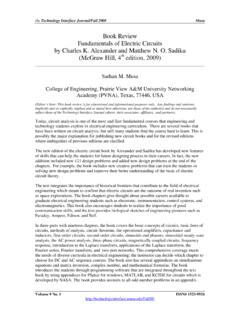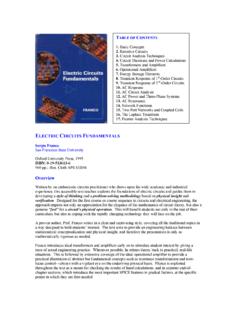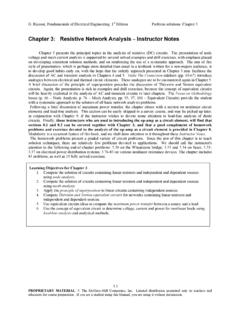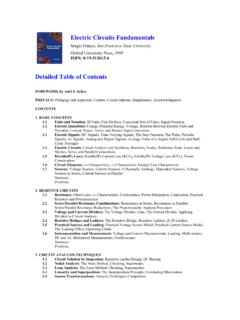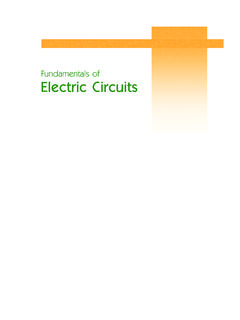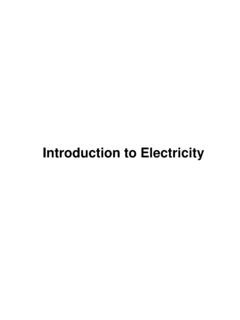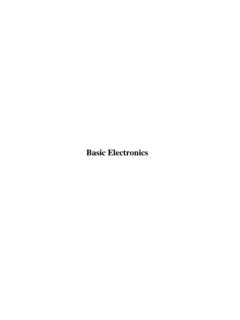Transcription of electronics fundamentals - staff.uob.edu.bh
1 electronics fundamentals 8thedition Floyd/Buchla 2010 Pearson Education, Upper Saddle River, NJ 07458. All Rights 2: Transistors and Applicationselectronics fundamentalscircuits, devices, and applicationsTHOMAS L. FLOYDDAVID M. BUCHLAE lectronics fundamentals 8thedition Floyd/BuchlaLesson 2 2010 Pearson Education, Upper Saddle River, NJ 07458. All Rights A transistoris a semiconductor device that controls current between two terminals based on the current or voltage at a third terminal. It is used for amplification or switching of electrical signals.
2 The basic structure of the bipolar junction transistor, BJT, determines its operating characteristics. DC bias is important to the operation of transistors in terms of setting up proper currents and voltages in a transistor circuit . Two important parameters are DCand DCElectronics fundamentals 8thedition Floyd/BuchlaLesson 2 2010 Pearson Education, Upper Saddle River, NJ 07458. All Rights junction transistors (BJTs)The BJT is a transistor with three regions and two pnjunctions. The regions are named the emitter, the base, and the collectorand each is connected to a are two types of BJTs npnand (Emitter)B (Base)C (Collector)EBCS eparating the regions are two junctionBase-Emitter junctionElectronics fundamentals 8thedition Floyd/BuchlaLesson 2 2010 Pearson Education, Upper Saddle River, NJ 07458.
3 All Rights junction transistors (BJTs)FIGURE 17 2 Transistor fundamentals 8thedition Floyd/BuchlaLesson 2 2010 Pearson Education, Upper Saddle River, NJ 07458. All Rights biasingFor normal operation, the base-emitter junction is forward-biased and the base collector junction is reverse-biased. npnBE forward-biasedBC reverse-biasedFor the npntransistor, this condition requires that the base is more positive than the emitter and the collector is more positive than the base.++For the pnptransistor, this condition requires that the base is more negative than the emitter and the collector is more negative than the ++ electronics fundamentals 8thedition Floyd/BuchlaLesson 2 2010 Pearson Education, Upper Saddle River, NJ 07458.
4 All Rights currentsFIGURE 17 4 Transistor electronics fundamentals 8thedition Floyd/BuchlaLesson 2 2010 Pearson Education, Upper Saddle River, NJ 07458. All Rights currentsA small base current (IB) is able to control a larger collector current (IC). Some important current relationships for a BJT are:IIIIBIEICECBIII CDC E II CDC B II Where DC(dc alpha)= IC/ IEWhere DC(dc beta)= IC/ IBElectronics fundamentals 8thedition Floyd/BuchlaLesson 2 2010 Pearson Education, Upper Saddle River, NJ 07458. All Rights biasR1R2 RCREVBVEVCB ecause the base current is small, the approximation2 BCC12 RVVRR is useful for calculating the base calculating VB, you can find VEby subtracting V for VBE.
5 VE= VB-VBENext, calculate IEby applying Ohm s law to RE: CEII Then apply the approximation Finally, you can find the collector voltage fromCCCCCVVI R EEEVIR ECCEVVV electronics fundamentals 8thedition Floyd/BuchlaLesson 2 2010 Pearson Education, Upper Saddle River, NJ 07458. All Rights biasCalculate VB, VE, and VCfor the k15 V = 27 k + kRVVRR R1R2 RCREVE= VB V = mAII CCCCC15 V mA kVVI R V kVIR 27 k k k k +15 VElectronics fundamentals 8thedition Floyd/BuchlaLesson 2 2010 Pearson Education, Upper Saddle River, NJ 07458.
6 All Rights biasDetermine VB, VE, VC, VCE, IB, IE, and ICin the given Figure, The 2N3904 is a general-purpose transistor with a typical DC= fundamentals 8thedition Floyd/BuchlaLesson 2 2010 Pearson Education, Upper Saddle River, NJ 07458. All Rights characteristic curvesThe collector characteristic curves are a family of curves that show how collector current varies with the collector-emittervoltage for a given = 0 The saturation regionoccurs when the base-emitter and the base-collector junctions are both forward curves are divided into three regions:The active regionis after the saturation region.
7 This is the region for operation of class-A breakdownregionis after the active region and is is characterized by rapid increase in collector current. Operation in this region may destroy the transistor. electronics fundamentals 8thedition Floyd/BuchlaLesson 2 2010 Pearson Education, Upper Saddle River, NJ 07458. All Rights characteristic curvesElectronics fundamentals 8thedition Floyd/BuchlaLesson 2 2010 Pearson Education, Upper Saddle River, NJ 07458. All Rights the family of collector characteristics curves for the circuit in the given figure for IB= 5 A to 25 A in 5 A increments.
8 Assume DC= 100 Collector characteristic curvesElectronics fundamentals 8thedition Floyd/BuchlaLesson 2 2010 Pearson Education, Upper Saddle River, NJ 07458. All Rights the family of collector characteristics curves for the circuit in the given figure for IB= 5 A to 25 A in 5 A increments. Assume DC= 100 Collector characteristic curvesIBIC5 mA10 mA15 mA20 mA25 electronics fundamentals 8thedition Floyd/BuchlaLesson 2 2010 Pearson Education, Upper Saddle River, NJ 07458. All Rights linesA load line is an IVcurve that represents the response of a circuit that is external to a specified load.
9 For example, the load line for the Thevenin circuit can be found by calculating the two end points: the current with a shorted load, and the output voltage with no load.+12 k 004812246I(mA)V (V)ISL= mAVSL= 0 VINL= 0 mAVNL= 12 VLoad lineElectronics fundamentals 8thedition Floyd/BuchlaLesson 2 2010 Pearson Education, Upper Saddle River, NJ 07458. All Rights linesThe IVresponse for any load will intersect the load line and enables you to read the load current and load voltage directly from the graph.+12 k 004812246I(mA)V (V)Read the load current and load voltage from the graph if a k resistor is the k RL=IVcurve for k resistorVL= VIL= mAQ-pointElectronics fundamentals 8thedition Floyd/BuchlaLesson 2 2010 Pearson Education, Upper Saddle River, NJ 07458.
10 All Rights linesThe load line concept can be extended to a transistor circuit . For example, if the transistor is connected as a load, the transistor characteristic+12 k 004812246I(mA)V (V)curve and the base current establish the fundamentals 8thedition Floyd/BuchlaLesson 2 2010 Pearson Education, Upper Saddle River, NJ 07458. All Rights linesLoad lines can illustrate the operating conditions for a transistor (mA)V (V)If you add a transistor load to the last circuit , the base current will establish the Q-point. Assume the base current is represented by the blue line.




